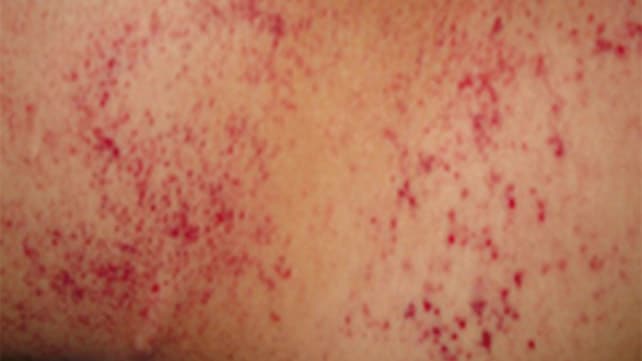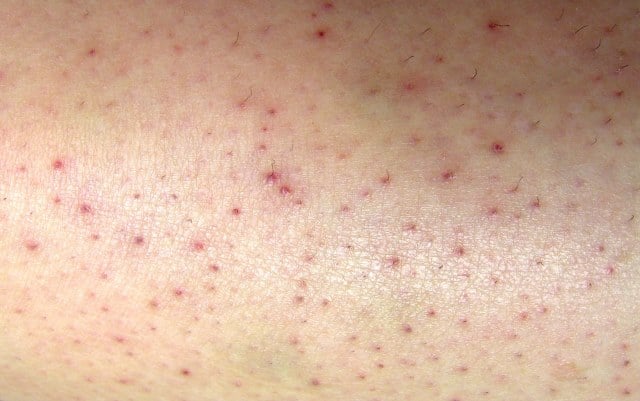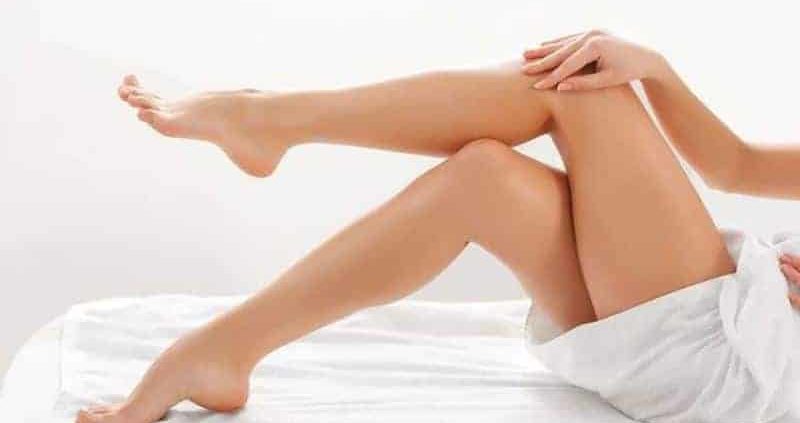Petechiae is a medical condition where you will develop small freckle-like spots on your skin. It refers to the hemorrhagic spot on the skin.
This appears as a group of spots that are reddish or purplish in color.
They most commonly appear on legs, face, arms, buttocks. In some cases, it is also found inside the mouth.
In most cases, these spots arise due to minor hemorrhage. They are harmless as they would resolve on their own in a few weeks even without any treatment.
Though Petechiae looks like a rash, they are not. One way to test is by pressing these it won’t turn white, where the rash does.
In case they seem to persist with other symptoms causing discomfort, then you need to get the medical attention.
Petechiae can occur anywhere in your body like on the skin of your face, ankles, back, shoulders but it is prevalent on the legs. So in here discover what are its symptoms, causes, and treatment.
Table of Contents
What Do Petechiae Look Like?
Petechiae are small, tiny pinpoint size hemorrhagic spots marks that occur on your skin. These spots are not more than 3mm and feel flat to touch.
Petechiae appearing on the legs are usually between 0.5 mm and 1mm in diameter. If the spots are more significant like more than 3mm, then they are referred to as purpura.
Like I mentioned earlier petechiae can occur anywhere on your body and they look like rashes because they emerge as clusters. When these spots first develop they appear red and in few days, they turn purple.
There are chances you might mistake petechiae for freckles, but the difference in their appearance is that freckles are brownish spots whereas petechiae are reddish purple.
One thing that will help differentiate petechiae from prominent blood vessels is that these spots will not fade away on the application of pressure whereas the blood vessels will.
Pictures Of Petechiae


What Are Causes Petechiae?
Here are some of the essential reasons as to why you might develop petechiae on your legs or another part of the body.
a. Trauma
This is one of the primary causes of petechiae to develop on your legs. When your body is subjected to high pressure or excessive force it causes injury to the blood capillaries on the skin resulting in a hemorrhage.
As a result of this hemorrhage, the red blood cells in the blood capillaries leaks resulting in accumulation under the skin. When the blood finds no opening to get out, it accumulates more and more beneath your skin as red spots called petechiae.
b. Medications
Petechiae can develop as a result of certain medications that can trigger allergic reactions inside your body. These spots can develop because of using drugs and medications like warfarin, aspirin, heparin, cortisone, penicillin, naproxen, cimetidine, carbamazepine, etc.
c. Fever
If you are suffering from fever, there are a lot of chances you might get affected by petechiae. The reason behind it in the meningococcus bacterium in your bloodstream.
Having other kinds of fever and diseases like dengue fever, Duke’s disease, cerebral malaria, Bolivian hemorrhagic fever, etc. can make you susceptible to petechiae. Autoimmune diseases and viral infections can also cause petechiae.
d. Cancer And Its Treatment
One of the major causes of petechiae is leukemia and bone marrow cancer. These two are fatal medical conditions where the platelet count of your blood begins to fall drastically. Petechiae can also result due to chemotherapy and radiation therapy which aid in curing cancer.
e. Thrombocytopenia
This is a medical condition that occurs due to low levels of platelets in the blood and turn, makes you prone to accruing petechiae.
Thrombocytopenia can affect a person as a side effect of the medication he/she takes for treating some infection. As a side effect of the drugs, the blood platelet count in the body decreases thus giving rise to petechiae.
f. Autoimmune Disease
In cases where you have an autoimmune disease, the immune system in your body will respond to the condition by producing antibodies. There are chances that these antibodies might wrongly attack the other tissues and organs of your body consequently damaging them. This damage can result in blood leakage under the skin.
g. Allergy
Petechiae can rise due to some allergies that are a result of certain medications that your body might not take in.
h. Sepsis
This is a severe medical condition resulting from an infection. When your body is affected by some disease, chemicals are released into your bloodstream in order fight against the infection. This reaction by your body can sometimes result in the inflammation of your entire body.
Sepsis puts a person’s life at risk because it may result in septic shock and drop in the blood pressure that might lead to death. Petechiae will result from a severe condition of sepsis.
i. Malnutrition
Lack of sufficient nutrients in your body and deficiency of vitamins like vitamin K, C, B, B12, B9, and folate can also be a reason for you to develop petechiae.
j. Strep Throat
This can be the reason for the occurrence of petechiae especially on the roof of your mouth. Strep throat is a throat infection caused by bacteria called streptococcus pyrogens.
k. Scarlet Fever
If you have a strep throat, then there are a lot of chances that you will develop scarlet fever. The scarlet fever is a bacterial infection that is accompanied petechiae (tiny red spots) that will have the appearance of rashes and will spread around your body.
l. Excess Strain
When your body is subjected to excess strain over an extended period, there are changes that you might get petechiae. This prolonged stress can be due to crying, childbirth, weightlifting, vomiting, continuous coughing.
m. Sunburns & Injuries
Physical abuse that involves spanking, biting, strangulation can also be the reason for developing petechiae. Injuries from car crashes and various other accidents can cause petechiae. Sometimes severe sunburns can result in petechiae.
What Are Petechiae’s Symptoms?
Symptoms and signs will help you in differentiating petechiae from rashes and other forms of blotches.
These are some symptoms that’ll help in identifying your condition:
i. Unlike rashes, the spots due to petechiae are flat. This reason petechiae are flat is that they develop under the skin.
ii. Petechiae are in the size of 1 to 2 millimeters. Even in their final stages, they will not exceed more than 0.5 centimeters.
iii. The color of petechiae turns from red (early stage) to dark bluish purple (final stage).
iv. When pressure is applied over the petechiae its color does not fade.
v. During the initial stages, petechiae develop individually and as time goes by these spots come together to appear as a rash.
Is Petechiae Serious?
In most cases, Petechies is a harmless condition. The good thing about Petechies that it doesn’t even leave any ugly scar mark on your skin.Though its a harmless condition but you should find out the cause of it. It might be an indication of the something serious.
- Infections in the body part
- Damage to the internal organ such as liver, kidneys, heart, lungs, spleen
- Problems related to heart
Treatment For Petechiae
If you want to treat petechiae on your legs, on your face or any part of your skin then you need to get to the bottom of it that is you’ll need to find the cause or the reason behind the development of petechiae and eradicate it.
1. Change Your Medication
If you have developed petechiae as a result of certain medications you are following, then you need to consult your doctor as to what can be done to treat your condition. Under the given circumstances your doctor might change the dosage of your medication or stop it altogether.
Sometimes we can be allergic to certain drugs and if you find it is the cause for you developing petechiae then discontinue it immediately.
2. Antibiotics
Infections can cause the development and appearance of petechiae, so antibiotics are prescribed to treat the condition. By taking the right medicines, you can not only reduce the presence of petechiae but also stay clear of the infection causing it.
3. Platelet Transfusion
If you have developed petechiae as a result of trauma/injury that has resulted in the damage of your blood capillaries which would have resulted in the decrease of your platelet count or going in for a platelet transfusion after consulting with your doctor can help in the reduction of petechiae.
4. Surgery
This is not an ideal option to eradicate petechiae on legs unless the cause is a malignant medical condition like leukemia or other forms of cancer. The primary aim of the surgery will not be to remove petechiae, but it will be aimed at treating the underlying medical condition.
5. Cold Compression
Here is something you can do at home if you have developed petechiae on your legs as a result of an injury of your blood capillaries beneath your skin you can apply a cold compress or an ice pack over the affected area to alleviate the condition. Remember to place a paper towel between the ice pack and your skin to keep the skin surface from further damage.
6. Supplements
Using supplements is away by which you can control petechiae by actually keeping a check on their causes. For examples, if you have developed petechiae as a result of some allergy then it can be treated with probiotics, thymus extract, protease enzymes, digestive enzymes and methylsulfonylmethane.
7. Vitamins
Vitamin deficiency is one of the reasons for the development of petechiae so if you make sure you take essential nutrients like vitamin C, K, D, B9, and folate the platelet count in your body will increase thus helping them in the reduction of inflammation caused due to petechiae.
8. Herbal Remedy
a. Herbs like dandelion roots will in detoxifying your liver, improves blood circulation and prevents petechiae. So when you have petechiae try to drink dandelion tea.
b. Greens like chlorella and spirulina aid in detoxification and treating the underlying cause of petechiae.
c. It is believed in Chinese medicine that using lotus roots, Rehmannia roots and peppermint can help in managing petechiae.
9. Homeopathy
Homeopathic remedies like cinchona officinalis, arnica Montana, Bellis, hamamelis, trinitrotoluene,sulphuricumacidum, Crotalushorridus, viperaberus, phosphorus, cortisone, acetic acid, muriaticumacidum, sanguinaria Canadensis, kreosotum, and Lachesis. All of these must be taken only under the supervision of a homeopathic practitioner.
10. Essential Oils
Applying walnut oil and avocado oil on your skin regularly give great texture and elasticity to your skin hence preventing the outbreaks of petechiae.
How Can I Prevent Petechiae?
If you want to prevent petechiae here are some tips that you can follow:
- Don’t lift too much weight that Is not more than what your body can handle.
- When you strain excessively during your bowel movements, it will cause internal pressure consequently damaging your blood vessels or avoid it.
- Garlic and onions are natural blood thinners so limit their intake. Also, avoid eating processed and foods that contain saturated fat and sugar.
- Eat a lot of berries, tomatoes, plums, and fruits like them because they contain a lot of antioxidants and help increase the platelet count in your body keeping petechiae at bay.
Bottom Of Line
I want to conclude by saying that if you or one your family members have developed petechiae, you need to seek medical attention and find the cause of this condition.
It’s vital to know the cause of petechiae because though the spots are harmless on their own and will resolve in a few weeks; they can be assign of an underlying disease or a medical condition that can be potentially grave, so be aware.





